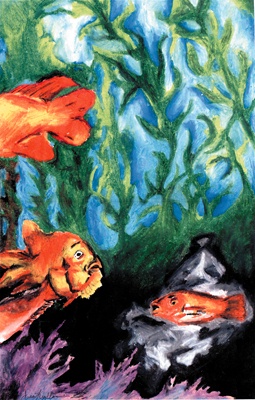All Nonfiction
- Bullying
- Books
- Academic
- Author Interviews
- Celebrity interviews
- College Articles
- College Essays
- Educator of the Year
- Heroes
- Interviews
- Memoir
- Personal Experience
- Sports
- Travel & Culture
All Opinions
- Bullying
- Current Events / Politics
- Discrimination
- Drugs / Alcohol / Smoking
- Entertainment / Celebrities
- Environment
- Love / Relationships
- Movies / Music / TV
- Pop Culture / Trends
- School / College
- Social Issues / Civics
- Spirituality / Religion
- Sports / Hobbies
All Hot Topics
- Bullying
- Community Service
- Environment
- Health
- Letters to the Editor
- Pride & Prejudice
- What Matters
- Back
Summer Guide
- Program Links
- Program Reviews
- Back
College Guide
- College Links
- College Reviews
- College Essays
- College Articles
- Back
The Fundamental Law of Life
When it comes to looks, women exhibit more concern about their physical appearance
than men. Fear and an unwillingness to accept the unavoidable effects of aging forces them to
resort to anti-aging drugs, and when all else fails - Botox. Unfortunately, even the costly
procedure of a face-lift simply provides a feigning escape from the inevitable decay of the body.
In 2010, Americans spent nearly $10.7 billion on cosmetic procedures
(www.cosmeticplasticsurgerystatistics.com), which were not medically necessary and often not
covered by their medical insurance. As humans, the idea of getting old is traumatic; hence, men
and woman seek to stay looking youthful. If a man or a woman was asked the question “Would
you want to live forever?” they would likely answer, “Yes.” Regardless of their gender, or race,
people seek the Fountain of Youth.
Despite medical doctors, such as dermatologists and plastic surgeons, being hailed as the
Gurus of attempting to reverse the aging process, it was a little known twenty year old biologist
who inadvertently tapped into the secrets of immortality. In 1988, a marine biologist by the
name of Sommer, who spent his summer in Rapallo, on the Italian Riviera, began his research.
Though most tourists visit the Rapallo area to see its historical monuments, Sommer dedicated
his time to research on hydrozoans – small animals living in seawater such as jellyfish and coral
(Wikipedia.org/wiki/Hydrozoa). One morning, while surveying the murky ocean floor, Sommer
spotted a comparatively insignificant organism, almost as small as a half-shaven pencil eraser.
Sommer collected the mysterious organism by using a net. After arriving at his cluttered
apartment, Sommer placed the organism into a petri dish and grouped it alongside the other
hydrozoans in the small nook of his room. Upon returning to his make-shift laboratory, he
realized the organism’s identity: Turritopsis Dohrnii. He thought he had a notable new species
to boast. To his surprise Sommer, the discovery of the Mediterranean species occurred five years
earlier, in 1883 (news.nationalgeographic.com).
After learning of the organism’s prior discovery, Sommer dismissed his specimen as
insignificant and commenced his research on the hydrozoans. During the first two days, Sommer
did not identify any significant observations on the hydrozoans, scribbling a few trivial notes on
their behavior. He spent most of his time performing cultures on the hydrozoans- a tedious task
which though mundane kept him preoccupied throughout the extensive research process. On the
fourth day, Sommer noticed a discrepancy in the reproductive behavior of the Turritopsis
Dohrnii. As the days progressed, Sommer’s interest in the specimen continued to grow, yet his
findings puzzled him. They contradicted a fundamental law of life: all organisms decay over
time and die. Sommer observed these organisms reversing their aging process. He “…could [not
hypothesize an] earthly explanation” (www.nytimes.com). Unable to fully comprehend his
observations, and reluctant to report his hypothesis for fear of being discredited as a scientist, the
public remained uninformed of his discovery for nearly a decade.
Fortunately, a group of scientists intrigued by Sommer’s observations, continued
studying the hydrozoan and affirmed his hypothesis: As stress encroached, the Hydrozoan
organisms began reversing their aging cycle, reverting to their initial stage and repeating their
life cycle anew (www.nytimes.com). The Hydrozoans were capable of performing a reversal of
the aging process, which has never been observed in any living organism. Regardless of whether
the organism was debilitated, starved, or threatened they thrived under insurmountable stresses
and reversed their decaying or aging. Even predatory animals, which could inflict potential harm,
spurred the Turritopsis to prosper indefinitely. Science had finally contradicted one of the
fundamental laws of life. Imagine the potential for curing illness by having cells within our
bodies rejuvenate themselves. Here was finally a significant advancement that could be applied
to improving the human race’s health, and it was not making headlines.
Unraveling the mystery behind the organism’s immortality could increase the longevity
of human life or, at the very least, improve humans’ well-being in their final stages of life. Why
was the science community ignoring these miraculous findings? Regrettably, their impassive
reaction to this profound discovery was presumably due to the lack of scientists trained in the
area required to further study the specimen. According to James Carlton, professor of marine
sciences at Williams College, “Finding really good hydroid experts is very difficult. You’re
lucky to have one or two people in a country” (www.nytimes.com).
Given the difficulty in finding a maritime scientist in this particular field, it is fortunate
one of these scientists proceeded to gather insight on these species. In a small beach town off the
coast of Wakayama Prefecture, Japan, Shin Kubota cultivates the Turritopsis Dohrni successfully
(www.nytimes.com). Kubota lives in a secluded area off the shoreline of Shirahama, a tranquil
and pristine seascape (Wikipedia.org/wiki/Shirahama). However, commercial development
and tourism poses a threat to Kubota’s sanctuary. At nearly 60 years of age, Kubota remains
optimistic for the town and for his continued research. Kubota visits his laboratory every day
to culture his Turritopsis. Cluttered with papers, disorderly equipment and other misplaced
objects, Kubota tirelessly works in his cubicle-sized laboratory. The petri dishes containing the
Turritopsis Dohrni are displayed haphazardly on top of a mini-refrigerator in the middle of the
laboratory (www.nytimes.com). Thankfully, Kubota is continuing to further the research on
Hydrozoans.
Most scientists find the task of incorporating the Turritopsis’ genetic code into beneficial
medical purposes far too intimidating and are reluctant to provide any sure claims as to whether
or not the Turritopsis will advance medicine in any way (www.nytimes.com). However,
Kubota’s bizarre level of optimism gives him the resolve to delve into the research behind the
Turritopsis’ biology and to hopefully discover the benefits to the field of medicine.
In an interview with a college graduate from the University of Miami, who
prefers to remain anonymous, I asked whether immortality was of any interest to her and, if so,
what the benefit would be to humanity or if she believed immortality should not be tampered
with. She responded by saying, “I do not believe immortality should be tampered with because
of my religious beliefs. However, I think it would be a very helpful study to conduct given that
from advancements in science we have been able to increase the quality and longevity of life.” It
is an understandable presumption that discovering the “fountain of youth” would have ethical
ramifications. If we had the same ability to reverse the life cycle as the jellyfish, our genes would
be the blueprint for the cellular regeneration. In essence, our physical structure and organs would
be an exact copy of the original. However, the regenerated organism would not share the same
memories as the prior organism. By having a new replica or copy of the old organism, we would
be diving into cloning the human race. The clones would be duplicates of the original
organism’s structure, but would be stripped of the source’s experiences and memories – a new
world of human replicas could emerge without the authenticity or uniqueness expected.
In another interview with a graduate from Northwestern, who prefers to remain
anonymous, I asked “What effect would discovering the key to immortality have on the world?”
He provided the following response: “Finding the key to immortality would be an incredible feat
for humanity. However, although at first glance a scientific revolution like that would be helpful
to humanity, in the long run it could have devastating effects on society, such as overpopulation,
which could have negative effects on the delicate balance of nature.” If everyone was potentially
immortal, there would be a significant decrease in the death rate as the birth rate would continue
to rise. Land, energy and food would become scarce resources. If not handled with care,
immortality could impede our society’s progress in the long run. However, if these organisms
prove to hold the key to a major advancement in medicine for the benefit of human life, we
would be irresponsible to ignore such findings.
Sources
Peterson, Lainie. "How Does Cosmetics Advertising Work?" wiseGeek. wiseGeek, 23
Nov. 2012. Web. 20 Feb. 2013. <http://www.wisegeek.com/
how-does-cosmetics-advertising-work.htm>.
Rich, Nathaniel. "Can a Jellyfish Unlock the Secret of Immortality?" The New
York Times [New York] 28 Nov. 2012: n. pag. Print.
Schuchert, Peter. "Hydrozoa." Wikipedia. By Robert D. Barnes and J. Boullion,
M.D. N.p.: n.p., 2013. Print.
"Shirahama, Wakayama." Wikipedia. N.p.: n.p., 2013. 1. Print.
Than, Ker. "'Immortal' Jellyfish Swarm World's Oceans." National Geographic News
29 Jan. 2009: 1-2. Print.

Similar Articles
JOIN THE DISCUSSION
This article has 0 comments.
